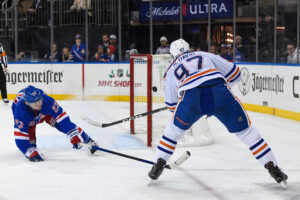The NHL has announced plans for returning to play this Summer, coronavirus-permitting. The regular season is now officially over and in the record books with the playoffs coming up. But there was also something for teams that aren’t invited to the second season: the format of the 2020 NHL draft was also announced. We, like every other hockey fan around the world, have opinions. And what good is working when you can’t argue with your boss?
The 2020 NHL Draft Works
What’s in a Draft Lottery?
Normally, the NHL would have 16 teams in the playoffs and 15 teams missing. If the league had gone with this format again it would first have to decide who made the playoffs. With an unequal number of games against various levels of competition, it’s difficult to find an equitable balance. The argument is always there that a team just outside the bubble could have gone on a hot streak. Someone in a playoff spot could have fallen out.
The draft is typical of the type in nearly any professional sport. The weaker teams get earlier picks in the hopes they will improve. Conversely, stronger teams get lower picks. The NHL has the addition of a draft lottery, giving every team that has missed the playoffs a chance to move into one of the top three positions. Odds are weighted, so better teams are less likely to win. With only three spots available, the worst team won’t fall too far even if they lose all three chances.
After a full, 82-game season it’s easy to see who is in and who is out. While the standings aren’t league-wide, but conference-wide, it’s still reasonably fair. Eight teams per conference get the chance to play for the Cup while the rest cross their fingers. With this season coming to a crashing halt, though, the usual draft lottery can’t apply. There has been an unequal number of games played and only a few teams had been mathematically eliminated. Giving teams who were close to playoff positions a chance to make it seems fair. But teams that were virtual locks, even with a dozen games remaining, should be in, too. The solution they have decided on is to give 24 teams a chance at the Stanley Cup.
Playing Dozens
They’re not willing to scrap the regular season standings entirely, though. The teams in the top-4 positions in each conference are guaranteed their spot. Everyone else – or at least those with even a remote chance at the playoffs – will have to work for it. This is where we’re getting the Sweet-Sixteen-Not-Really-Playoffs. What the heck does that mean for the draft lottery, though?
Starting at the Bottom
The league has divided the teams into three categories:
The first category is teams that are officially eliminated. This includes the Detroit Red Wings, Ottawa Senators, San Jose Sharks, Los Angeles Kings, Anaheim Ducks, New Jersey Devils, and Buffalo Sabres. These teams aren’t playing any more games, so have their final standings fixed in that order, worst-to-best. For them, the chances of winning the first overall pick are 18.5%, 13.5%, 11.5%, 9.5%, 8.5%, 7.5%, and 6.5% respectively.
The more astute will notice that equals somewhat less than 100%. That’s because the odds are the same as if 15 teams were in the draw. This is because 15 teams are in the draw, we just don’t know who yet.
Crazy Eights
Remember that “Sweet Sixteen” crack? The next sixteen teams in the regular season’s standings are paired up to play for eight playoff spots, four in each conference. With that seeding done, the regular season’s standings are thrown out the window. Seriously, that’s it. We’re finished with them as far as the 2020 NHL draft lottery is concerned.
This second category of teams – those who finished the regular season between fifth and twelfth – are now in a best-of-five series to see who is in and who is out of the playoffs. They are:
Hurricanes vs. Rangers
Oilers vs. Blackhawks
Win three of your games in this round and you’re in. Lose, you go to the draft lottery. Which is where the objections really get going, though they probably shouldn’t.
Men of Letters
The eight teams that are eliminated in this round officially do not make the playoffs. Teams that don’t make the playoffs are in the draft lottery. But the draft lottery has already happened before we know the final eight teams taking part. So those final eight positions in the lottery are taken by placeholder letters. The letters correspond with the usual seeding: A has a 6% chance of winning, B has 5%, C has 3.5%, D has 3%, E has 2.5%, F has 2%, G has 1.5%, and H has 1%. If one of these placeholders wins any of the three top draft positions in the lottery, another lottery gets held.
So eight teams are now eliminated from the playoffs, so they now have to get placed in their draft position. But they didn’t play out the regular season, which is what the best-of-five tournament is replacing. None of these teams played each other, so their relative strengths are difficult to measure. If the idea of a draft is to benefit the weaker teams the most, what do you do with an eight-way tie?
In this case, you have another lottery to determine which of those eight teams is what letter. All of the eight eliminated teams have an equal chance of getting assigned any of those eight letters.
The third category of teams is the top four of each division. They’re off doing their own round-robin to get warmed up for when the playoffs start.
The 2020 NHL Draft Lottery Math
Let’s delve into hypotheticals here. One of the more common complaints is “what if the Penguins lose to the Canadiens, then win the lottery?” This is a reasonable objection. Pittsburgh had the most points of all the “play-in” teams and was seventh-best in the league when the regular season ended. The problem is that while we can guess, we can’t actually predict the future. It’s not out of the realm of possibility that one of the four teams chasing them could catch them. Could three do so? Almost certainly not, with so few games remaining.
But “almost certainly” is not “certainly”, and how do you recreate “almost”?
Should Pittsburgh lose out to Montreal, they will be a non-playoff team. Non-playoff teams get a shot at the draft lottery. The same thing will be said if Montreal loses to Pittsburgh. If the playoffs were determined by standings when the season ended, Montreal would have finished 24th overall. That would have given them a 6% chance at winning the draft lottery. Ask their management at church if they would rather face the Penguins or have a 6% chance at Alexis Lafreniere…
In this version of the draft, if Montreal loses their play-in, they will be assigned a letter at random. If, as an example, the first overall pick is won by the letter A – something that has a 6% chance of happening – the Habs will have to win another lottery to get that pick. They’ll have one chance in eight to win the draft position they would have had if not for their chance to make the playoffs.
Wait, What?
Montreal could win their matchup against Pittsburgh. This is to compensate for the chance they had to make the playoffs if the regular season had continued. Pittsburgh might get pushed out of a near-certainty to be in the playoffs by Montreal. In exchange for that risk, they can get a spot in the draft lottery. That’s the trade-off all of the sixteen teams going through the play-in are making. A chance to play for the Cup vs. a lottery ticket at the draft.
One of the placeholder letters could win the top pick of the draft – collectively they have a 24.5% chance. That’s the same odds as last year. Then one of the play-in losers has to win that specific letter, something they have a one-in-eight chance – 12.5% – of doing. That’s a three percent (well, 3.0625%) chance of getting to draft a generational talent in Alexis Lafreniere. As mentioned, normally places eight-through15 would have 6%, 5%, 3.5%, 3%, 2.5%, 2%, 1.5%, and 1% chance of winning the lottery. Instead, they all have the same 3(-ish)% odds.
How is that fair to Montreal, who sees their odds cut in half? It’s not, particularly. But we also don’t know where they would have finished had the season played out. They may have worked their way up to 2%, so now their odds are better than otherwise. They could have dropped into the 8-9% range. In a weird, one-off season it’s a compromise and an effort at fairness that works pretty well. Not perfectly, but pretty well.
A chance to play for the Stanley Cup, or a chance to win the 2020 NHL draft and select the best young player in years? For the league’s middle-twelve teams, it doesn’t sound like a bad trade-off.
Main Photo:






